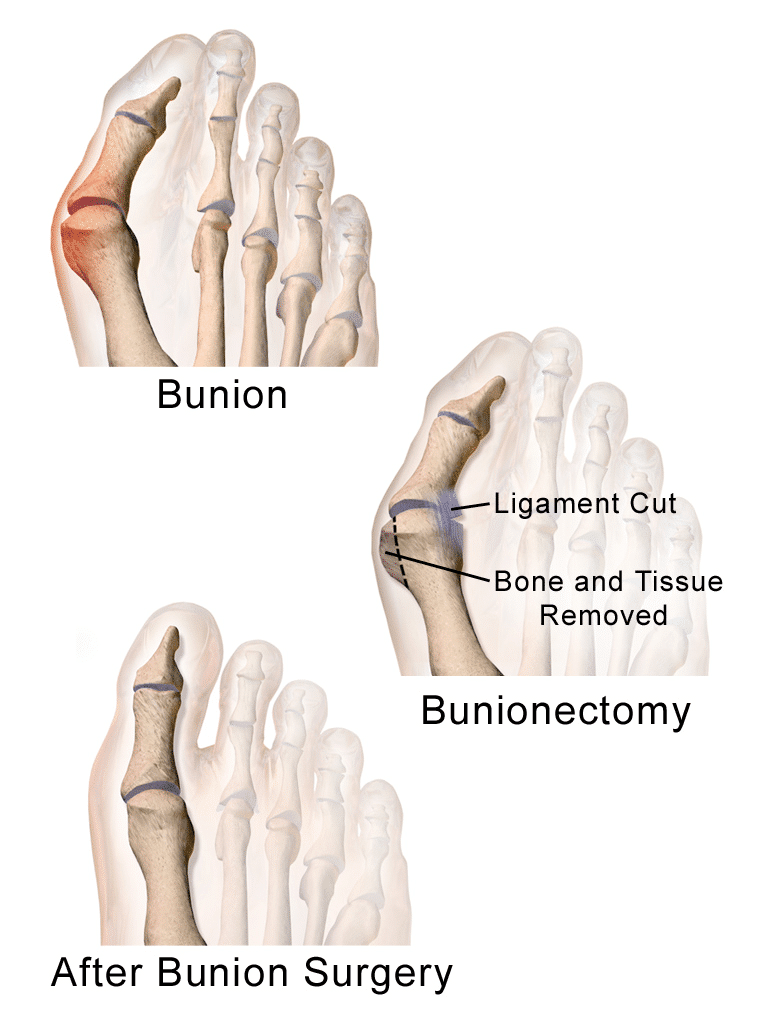Bunionectomy – Overview
Bunionectomy is a surgical procedure carried out to remove a bunion – a deformity of the joint connecting the big toe to the foot. With a bunion, the big toe often bends towards the other toes and the joint becomes red and painful. The exact cause of a bunion is unknown but proposed factors include wearing overly tight shoes, family history of the condition and rheumatoid arthritis.
If conservative methods of treatment such as changes in footwear use of padding, ice and pain medications are not effective, a bunionectomy may be necessary to treat the condition.

Bunion
Types of Bunionectomy
There are various types of bunionectomy and the procedure chosen depends on the extent of the bunion, your age and general health. Some of the types of bunionectomy include:
- Lapidus Bunionectomy
The Lapidus bunionectomy is considered the Gold Standard for bunion surgery. For the right patient, this procedure has the highest success rates with essentially a 0% chance of the bunion returning.
This procedure has the lowest risk of re-occurrence of the bunion because the Lapidus bunionectomy addresses the source of the bunion deformity (a loose/hypermobile 1st metatarsal and cuneiform joint). The Lapidus procedure is ideal for a moderate to a severe bunion or there is a significant amount of hypermobility
- Austin or Chevron Procedure Long Arm Osteotomy
This is one of the most commonly performed bunion surgery. An osteotomy, or bone cut, is made on the metatarsal head, just behind the big toe joint. This “V” shaped cut (when viewed from the side) allows the first metatarsal to shift laterally toward the second metatarsal bone. The bones are held together in their newly corrected position with two screws. Although the screws may not be needed after the bone is healed, they are often left in place to avoid a re-occurrence of the bunion.
- McBride Bunionectomy
The McBride bunionectomy is not commonly performed as it involves removing the bony bump without cutting the bone and shifting it. That being said, it is used when there is a mild bunion or if the patient is a poor surgical candidate that may not heal well from an osteotomy (bone cut). While the McBride bunionectomy is an acceptable procedure, it does not provide the same type of correction, as do procedures involving an osteotomy.
Other types of bunionectomy are Scarf Bunionectomy, Akin Bunionectomy, Opening Wedge Bunionectomy and Tailor’s Bunion Surgery. Make sure to speak with your surgeon to come up with a type of bunionectomy that will meet your needs.
Related: Patella Surgery
Bunionectomy Procedure
Bunion surgery generally takes about an hour and it can be performed under local, spinal or general anesthetic. The type of anesthesia will depend on the patient’s condition and the anticipated extent of the surgery.
The surgeon will make an incision over the swollen area at the first joint of the big toe. The enlarged lump will be removed. The surgeon may need to reposition the alignment of the bones of the big toe. This may require more than one incision. The bone itself may need to be cut.
If the joint surfaces have been damaged, the surgeon may hold the bones together with screws, wires, or metal plates. In severe cases, the entire joint may need to be removed and a joint replacement inserted. If pins were used to hold the bones in place during recovery, they will be removed a few weeks later.
In some mild cases, it may be sufficient to repair the tendons and ligaments that are pulling the big toe out of alignment. When finished, the surgeon will close the incision with sutures and may apply steri-strips as an added reinforcement. A compression dressing will be wrapped around the surgical wound. This helps to keep the foot in alignment as well as helps reduce postoperative swelling.

Bunionectomy
Bunionectomy Risks and Complications
As with any surgical procedure, there are risks associated with bunion surgery. General risks associated with all types of surgery such as anesthetic risk, bleeding, infection, wound healing problems and unfavorable scars are all still possible.
Bunionectomy Cost
The total cost for bunionectomy depends on a lot of factors such as the anesthetic fee, private hospital fee, private operating facility fee, the extent of surgery required. The total cost of the procedure is around $350 – $1000.
Bunionectomy Recovery
After bunion surgery, you can expect a 6- to 8-week recovery period during which crutches are usually required to aid mobility. Hardware may include absorbable pins that perform their function and are then broken down by the body over months. After recovery long-term stiffness or limited range of motion may occur in some patients. Visible or limited scarring may also occur but will fade with time.
Once wound healing has taken place, the surgeon may recommend exercises or physical therapy to improve foot strength and range of motion.
More: Rib Removal Surgery


